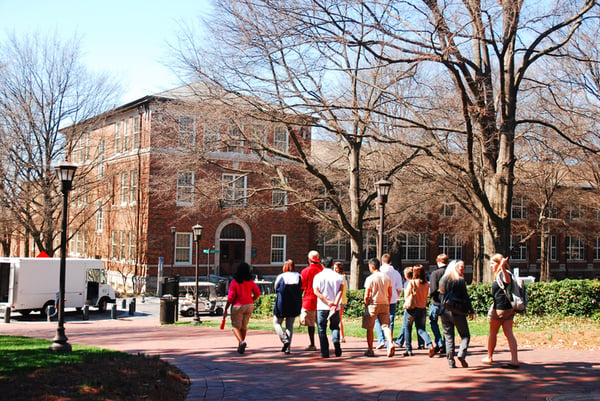- SERVICES
- HIGHER EDUCATION MARKETING
- ENGAGEMENT & ENROLLMENT MANAGEMENT
- STUDENT RECRUITMENT AGENCIES
- PROFESSIONAL EDUCATION & TRAINING
- WHO WE ARE
WHO WE ARE
Learn more about Keystone Education Group, including our leadership structure, why choose Keystone as your educational partner, and company press releases.
QUICK LINKS
- RESOURCES
RESOURCES
Find a range of helpful resources to help with your educational marketing. From on-demand webinars, reports & data, to customer testimonials and our downloadable media kit.
QUICK LINKS
- NEWS
- REQUEST A CALL

- Keystone Higher Education News
- Marketing a Return to Campus Learning for Online Courses
Heading back to campus is a new, yet familiar, normal. Amid a global pandemic, colleges and universities ramped up their online course offerings — and this momentum doesn't seem to be slowing down.
But even with more online programs, students are ready (eager even) to return to campus.
A campus is a place students know or have dreamed of returning to to study.
According to our 2022 State of Student Recruitment Report, 61% of students surveyed said they prefer in-person classes. In fact, undergraduate, postgraduate, and Ph.D. students prefer on-campus versus fully online and hybrid.
This is an increase from 53.6% in 2021, showing a clear desire for students ‘to get back to a pre-pandemic normal’. Only 6.9% voted for online classes, while 31.1% voted for a hybrid mix of the two. And for many, the benefits of being on campus outweigh the alternatives.
But, after two years of working online, here are six marketing suggestions to promote the benefits of campus learning, living, or both.
Make health and safety your top priority
Although down from 2021, a recent report from Gallup shows that COVID-19 is one of the top emotional stressors for students considering dropping courses.
You can help ease anxieties by emphasizing your school's commitment to COVID-19 precautions. Include this messaging in all channels, from your website and social media to emails and campus signage. As restrictions ease, it’s vital to consider the broader campus community. Some students, faculty, and staff continue to socially distance and avoid events, and although masks may no longer be required everywhere on campus, emphasize respect for the decisions of those who choose to wear them.

Give reason and rationale for in-person campus visits
In a survey by BHDP, 95% of respondents said a campus tour was important in their decision to enroll, with 85% saying it was “very” or "extremely” important.
Why is an in-person campus tour more crucial now than ever before?
Fox Truolio of Hanover Research describes them as ‘very powerful for a student to envision themselves at that institution’. They continue, “There’s something about creating that bond by literally having your feet in the grass or walking through a classroom and touching the seat.”
Out of 26 potential factors that may have influenced a student’s college choice, “look and feel of campus” was the seventh-most popular factor in a recent Student Voice survey.
Admissions teams can encourage signing up for an in-person campus tour, pointing out that viewing campus from your smartphone is not the same experience. It’s difficult to see yourself somewhere you’ve only seen through a small screen in your hands.
How do you emphasize this? Your social media and website should keep in-person campus visits front and center, mentioning them first and listing the benefits.
Create a blog or podcast about “Seven reasons to come to your campus” and list specifics for your school, such as sitting in on a renowned professor’s lecture, exploring a lab, staying overnight in a dorm, walking on the football field, or taking a selfie in front of a famous campus landmark.
Some universities, like Bellarmine, offer an “official visit campus” scholarship to encourage visits. It’s an opportunity to hand out branded gifts, hype personalization with custom parking signs, and make that FTF connection a lifeline for you and the student.
And if coming to campus is not an option, reach students with authentic short-form videos on TikTok, Instagram Reels, and YouTube. Capture all facets of student life — athletics, community, dorms. This gives “as close to the real thing” experience as possible.
Capture student information in your CRM from RFIs and contact them via email or phone. Make a real connection right away. This makes up for missing the in-person experience.
Stress the Social Factor
It’s not surprising that the top answer to what students missed most about campus life during the pandemic is “friends and social life.” Nearly three-quarters selected this in an Inside Higher Ed / College Pulse survey.
As Hannah Cron, a sophomore last year at Lipscomb University in Tennessee, told The Guardian, “It’s hard to feel like you fit in and belong somewhere if you’ve never met the people around you, and that’s been really hard."
A sense of community and personal connections are formed on campus, and students often converse with each other during and after class — which is rarely done online.
Many graduate students don’t have much time for friends, so in-person classes are often their only social interactions all week. This bonding also happens with professors by creating a rapport that can only be formed in person.
As Cron states, “Overall, the benefits of going back to classes in person outweigh the negative aspects.”
The college experience
Undergraduates living on campus are excited about clubs, intramural sports, Greek life, homecoming, and dorm life.
But simple things like late-night chit-chats with roommates and walking across campus on a fall day make the college experience memorable. Moments that can't be experienced on Zoom.
Short-form videos (90 seconds) on TikTok or “a day in the life” YouTube videos are the best way to show moments like these — a student strolling across campus during a snowfall, going to a Yoga class behind the student union, or taking in a game on a Friday night.

Make a personal connection
Interactions such as a prospective student or parent meeting an admissions counselor in person are crucial for Gen Z. Despite being digital natives, Gen Z still seeks real connections. They also crave community and belonging. They won’t feel this with automated SMS and emails, or links to stories and testimonials that don’t apply to them.
Take the time to listen to what they want, create meaningful connections, showcase community on your campus, and show what belonging means at your college or university.
Stress not all programs can be taught online
Online classes can only take nursing and pre-med students so far. But other programs — agriculture, biology, chemistry, and theater — need in-person learning. Many of these are hybrid, but labs, clinical practice, performances, and field studies require students to come to campus.
Programs like these can leverage your marketing strategy in a big way.
Creating program-specific marketing campaigns helps enrollment efforts by showcasing what makes your campus different — innovative technology, state-of-the-art labs, renowned research facilities, and notable performing arts centers.
Use Instagram and YouTube to show what happens in these places: a musical, chemistry experiment, or sustainability project.
Our 2022 survey of 20,000 prospective students reported students first consider “the program” versus the school when deciding where to study. This factor has jumped by 14.6% in importance in 2022, while the school itself has declined by 25.5% this year after a steady rise over the last three years.
It’s not the brick and mortar, but the engagement and collaboration that will take shape on campus that can only go as far as a screen with online classes.
Take it from senior Isabel Caesars of the University of Pennsylvania. “I think online classes are definitely not the same as being in person, because you miss out on such a big socialization component," she told The Daily Pennsylvanian.
Today, about 1 in every 4 students claim that they learn better via online classes. This means that 3 out of 4 students still feel they perform better in a traditional classroom setting.
Isabel explained, "It can be difficult for some material to translate well onto computers, especially for discussion-based classes."
Traditional in-person education has been around forever. Its numerous perks make it impossible for it to be entirely replaced by any other learning format. But it’s a decision each student needs to make for themselves.
Knowing more students want the in-person experience can help you market your programs and school — and help bring more students back to campus.
More about:
Related Tags
Just For You
Top Picks
Higher Ed Chats Podcast
Listen to the latest episodes of our Higher Ed Chats Podcast. Hear from Higher Ed thought-leaders from around the world!
The Keystone Awards 2026:
Nominate your institution or a student

Recognize your your university, team, colleagues and students for a Keystone Award!
Subscribe
to get the latest news and updates


